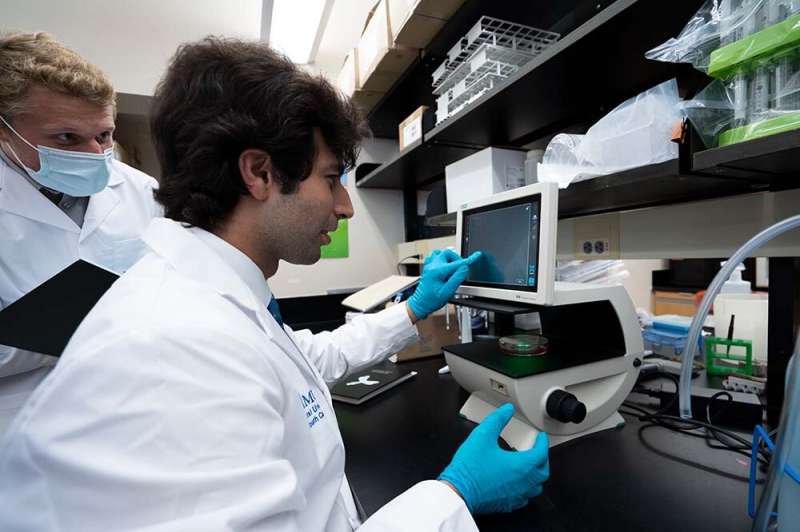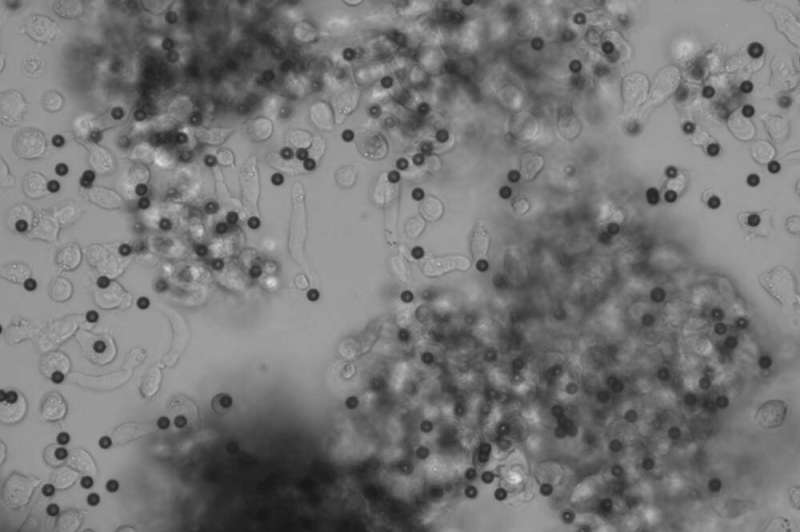Dr. Leonardo Ferreira’s research involves optimizing chimeric antigen receptors on T-cells to better direct the T-cells to certain targets. Credit: Marquel Coaxum
Medical University of South Carolina (MUSC) Hollings Cancer Center researcher Leonardo Ferreira, Ph.D., well-regarded for his pioneering work with regulatory T-cells, has published a paper in Frontiers in Immunology that describes his experience using chimeric antigen receptor (CAR) regulatory T-cells to address the challenge of transplant tolerance.
Ferreira, who joined the Medical University of South Carolina's Department of Immunology on July 1, is changing the rules of the game by exploiting the unique biology of regulatory T-cells, or Tregs. His overall research goal is to understand Treg biology more thoroughly in order to use the cells to treat a range of autoimmune problems.
"I became passionate about the immune system while getting my Ph.D. at Harvard. My mentor was Dr. Jack Strominger, who crystallized the structure of HLA proteins back in the 1980s. Understanding HLA is so important in immunology because it is one of the main 'keys' of how our bodies recognize our own cells from foreign cells, or self versus non-self," explained Ferreira.
In his postdoctoral training at the University of California San Francisco (UCSF), Ferreira turned his focus to engineering the immune system of organ transplant recipients to reduce transplant rejection. "Right now, it is hard to find a match for patients who need organ transplants. This is because matching the HLA proteins is a major barrier. Humans have 18 different types of HLA proteins, which is why there is a huge organ donor database, yet so few patients matched with donors."
Ferreira thinks of the immune system as an army. The Tregs are the "generals," and the other immune cells are the "soldiers." The Tregs guide the other immune cells by suppressing them when they become over-activated, as in autoimmunity, and by letting them fully function when there is a threat, such as infections or cancer.
"The immune system is involved in every body function; it is not static. T-cells have 'X-ray' vision with blinders to see only the intracellular proteins in other cells that they are supposed to attack," said Ferreira.
For the past five years, he has been optimizing CARs to direct T-cells to certain targets. A CAR replaces a T-cell's normal surface receptor, the T-cell receptor, or TCR, which assigns the T-cell to a single surface HLA protein complex. Ferreira's research involves taking immune cells from people and studying them, with the goal of using Tregs as "living drugs."
Following stimulation by beads coated with antibodies (dark spheres), regulatory T-cells form “cotton candy-like” clusters around the beads. The elongated “banana-like” shapes are stimulated regulatory T-cells that have left the clusters to go carry out their function. Credit: MUSC
Type 1 diabetes is a useful model for determining if the CAR Tregs are functioning therapeutically. The CAR Tregs are designed to go to the pancreas and put out the autoimmune fire. Insulin has been used as a Type 1 diabetes treatment for 100 years as of this year, but it does not treat the source of the problem, he said. Immunology can get to the root of the problem by stopping the chronic inflammation that is causing the disease.
Ferreira said that the research described in the Frontiers in Immunology article is one of the first to precision engineer CAR Tregs using a gene-editing method called CRISPR-Cas9. This process is like using a scalpel to remove the original Treg TCR precisely and then insert the CAR in its place. This method is safer because it ensures that only one copy of the CAR is present and that the CAR is regulated in the same way as the original TCR.
Using a "humanized" mouse model of diabetes with human islet cells and human immune cells, Ferreira and his colleagues at UCSF found that the CAR Tregs could delay or reduce the damaging inflammation. He said that the rich biology of the Tregs is just now being explored, and the use of CARs may provide artificial tolerance with specificity. Ferreira is now conducting studies in his lab at Hollings to optimize and understand the CAR Treg biology more fully.
There are translational challenges that must be overcome before CAR Tregs can become living drugs, such as cost and approval. One biological hurdle is that Tregs only make up approximately 1 to 2% of the white blood cells, so getting enough cells for therapies is a challenge.
Ferreira believes that it is important to have a mix of basic science and translational research projects ongoing, since the results inform both areas of research.
"I am excited about using the clean cell facility here at MUSC. I have a garage full of different CARs and am eager to study how they work. There is the potential that some of the CAR Tregs can be used in cancer, and Hollings is the perfect place to collaborate with cancer researchers," said Ferreira.
His vision for the immunology program at Hollings is to help the cancer center continue to expand its cellular therapies and be a part of making this therapy more accessible to patients. "There is a powerful interactive dynamic between the research faculty here. The smaller faculty size combined with the collaborative atmosphere, translational resources and cGMP clean cell facility make this an exciting time to be a part of this great research community at MUSC," he said.
More information: Yannick D. Muller et al, Precision Engineering of an Anti-HLA-A2 Chimeric Antigen Receptor in Regulatory T Cells for Transplant Immune Tolerance, Frontiers in Immunology (2021). DOI: 10.3389/fimmu.2021.686439
Journal information: Frontiers in Immunology
Provided by Medical University of South Carolina

























